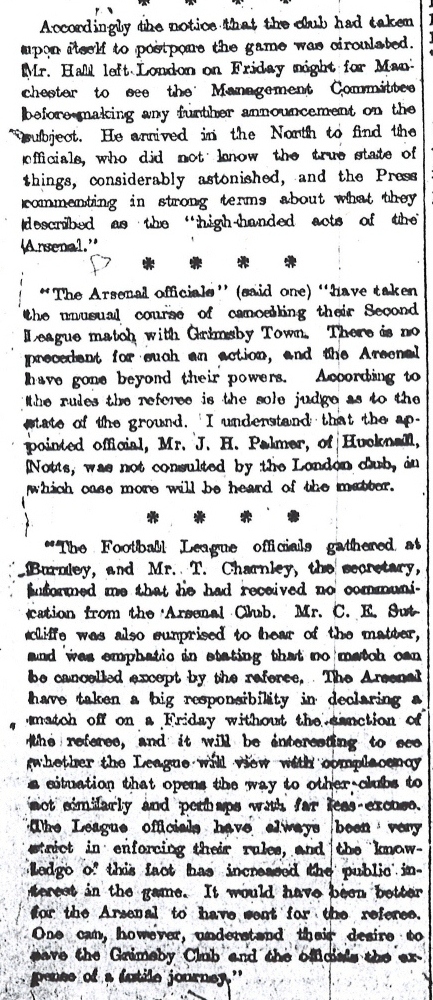by Andy Kelly
(@Gooner_AK)
A little over 6 months after moving into their new stadium at Highbury the Arsenal directors took the unilateral decision to shut the ground due to a subsidence problem. It’s unclear whether this was a defect caused by the builder or lack of supervision by Archibald Leitch, the architect. Leitch had a reputation for not checking the work carried out by contractors working on the stadiums that he designed. The Ibrox disaster of 1902 was blamed on the use of poor quality materials that had not been checked, whilst the terracing at Stamford Bridge had started crumbling soon after Chelsea took occupancy in 1905. In 1963, Alexander Kearney, Leitch’s assistant, confirmed that Leitch was too busy on other projects to properly supervise the construction site at Highbury.
On the evening of Thursday 19 March a torrential downpour hit north London. The sewers were unable to contain the rainwater which flooded down Highbury Hill pushing mud against the west terrace boundary wall. The wall was unable to take the pressure and started listing in towards the terracing.
The following morning the staff arrived at Highbury and noticed the problem with the wall. The directors were now faced with a dilemma. Arsenal were due to host Grimsby the next day.
A surveyor from the London County Council was called in and he told the directors that, although it was a danger to public safety, he would not condemn it or close the ground.
The directors discussed several options including not allowing spectators on to the west terrace and playing the game behind closed doors, but ultimately a decision was taken to close the ground until the wall was made safe. This was a risky option as it could result in a points penalty from the League. Even more so, as at the time Arsenal were second in the table and heading for promotion. Thankfully, the Football League saw sense and did not censure the club for taking this action.
As for what was needed to be done to the wall, the worst case scenario would have been that the wall would have to be demolished and re-built. The damage wasn’t that bad and, incredibly, the solution was to employ 100 labourers to shovel the mud that had built up against the wall onto the terrace!
Highbury finally reopened for business two weeks later for the reserve game against Fulham on 2 April. In total 3 games had to be postponed, including the reserve game against Portsmouth which had been designated as Charlie Lewis’ benefit game.
The enforced break appeared to put paid to Arsenal’s promotion challenge as they drew two and lost two of their next four games which saw them slip back to third place, eventually missing out on promotion to Bradford Park Avenue on goal average.
This video from 1919 on the British Pathe website shows a good view of the west terrace wall that started listing (from 00:15 to 00:48).
—————–
The books…
- Woolwich Arsenal: The club that changed football – Arsenal’s early years
- Making the Arsenal – how the modern Arsenal was born in 1910
- The Crowd at Woolwich Arsenal – crowd behaviour at the early matches
Other sites from the same team…
- Untold Arsenal
- Referee Decisions – just what are the refs up to this season?
The main series on this web site


The word “subsidence” made me smile,Andy, because it reminded me of the subsidence at the Highbury Stadium caused by German bombing early during WW2. The result was that our home games during the rest of the War were played at White Hart Lane by arrangement with our close neighbour, Spurs.
Andy,
Thanks for this detailed account
Having personally read many books on Highbury in the past few years it strikes me as strange that neither John Spurling in – Highbury: The Story Of Arsenal In N5 nor Brian Glanville in – Arsenal Stadium History included this story in their books.
It would be interesting to know how or why they missed this important event.
Probably because it’s only ever been told in Woolwich Arsenal: The club that changed football. I found the story whilst trawling through back issues of the Islington Gazette.
It’s the only way to write a truly factual history book.